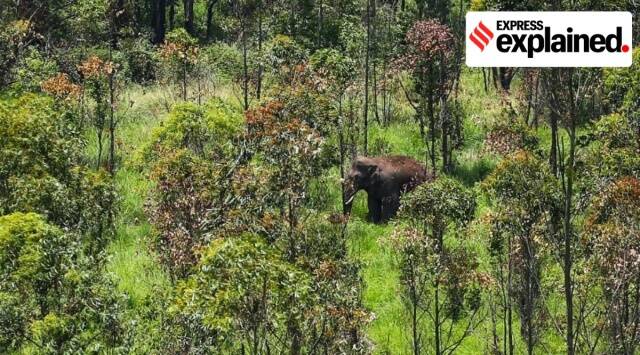What’s in today’s article?
- Why in News?
- Human-Elephant Conflict
- Why Human-Elephant Conflict is a Serious Issue?
- How to Avoid Human-Animal Conflict?
- Elephant Corridors
- Steps Taken by the Government
- News Summary
Why in News?
- After over a month since the forest department first mobilised its personnel in the state of Kerala, rogue elephant ‘Arikomban’ (literally, ‘rice tusker’ due to its known affinity to rice) has finally been captured.
Human-Elephant Conflict
- Elephant, being a large herbivorous animal, needs vast areas to roam: browsing, foraging, moving from place to place in search of food and water with the changing seasons.
- The ‘home range’ of an elephant herd can vary from an average of about 250 sq. km (in Rajaji National Park) to over 3500 sq. km (in the highly degraded, fragmented landscapes of West Bengal).
- As elephants are forced to range farther and farther afield, this brings them into conflict with humans.
· And as humans encroach on forest areas, planting nutritious crops near forest lands, building homes and roads and railways, this invites conflict with elephants.
Why Human-Elephant Conflict is a Serious Issue?
- Environment ministry data tabled in Parliament showed that the number of deaths due to elephants was 535 in 2021-22, down from 585 in 2019-20.
- Jharkhand (133) recorded the highest number of human deaths, followed by Odisha (112) and West Bengal (77) deaths in 2021-22.
- Elephant deaths due to humans stood at 82 in 2021-22, compared to 99 in 2019-20.
- Electrocution killed the maximum number of elephants, with Karnataka and Tamil Nadu recording the maximum deaths.
How to Avoid Human-Animal Conflict?
- Strobe Lights –
- To scare off destructive nocturnal wildlife, farmers increasingly rely on automatic light machines.
- Half strobe light and half motion sensor, the machines flash beams of light randomly in all directions to mimic a farmer with a flashlight.
- Wary nocturnal animals have been shown to avoid such light signals.
- Natural Barriers –
- To keep elephants at a safe distance from their farms and homes, some African villagers have turned to two unlikely, all-natural solutions: bees and hot peppers.
- Elephants dislike the chemical capsaicin found in chili peppers, prompting farmers in Tanzania to smother their fences with a mixture of oil and chili peppers.
- In addition to a spice aversion, elephants are also terrified of bees.
- This realization has led to the construction of bee fences around farms to keep marauding pachyderms out.
Elephant Corridors
- One way to reduce conflicts with wild animals is by guiding their movements in developed areas through dedicated corridors.
- Elephant corridors are linear, narrow, natural habitat linkages that allow elephants to move between secure habitats without being disturbed by humans.
- Elephant corridors are also critical for other wildlife including India’s endangered National Animal, the Royal Bengal tiger (Panthera Tigris).
- Elephant Corridors in India –
- Number of elephant corridors in India have been changing over the years.
- 88 corridors were identified jointly by the Ministry of Environment, Forests and Climate Change and Wildlife Trust of India (WTI), and published in 2005.
- Wildlife Trust of India is an Indian NGO committed to nature conservation.
- In 2015, a second round of identification took place — and when published two years later, the number of corridors had gone up to 101.
Steps Taken by the Government
- Project Elephant:
- Project Elephant was launched in 1992 by the Government of India for the protection of elephants, their habitats and corridors.
- The Ministry of Environment, Forest and Climate Change provides the financial and technical support to major elephant range states in the country through Project Elephant.
- The Project is being mainly implemented in 16 States/UTs.
- India had 29,964 elephants as per the last census in 2017, about 55% of the species’ global population.
- Gaj Yatra:
- Gaj Yatra was launched by the Government of India on the occasion of World Elephant Day in 2017.
- It is an awareness campaign aimed to help secure Right of Passage for elephants through 101 vital migratory corridors mapped across India.
News Summary
- After over a month since the forest department first mobilised its personnel in the state of Kerala, rogue elephant ‘Arikomban’ (literally, ‘rice tusker’ due to its known affinity to rice) has finally been captured.
- The elephant wreaked havoc in the human settlements of Chinnakanal, Santhanpara and Bodimettu, raiding the ration shops for rice and other grains.
- It has been responsible for trampling as many as 11 people to death over the years.
- A team of 150 forest officials darted the rogue elephant with five tranquiliser shots after finally locating the elusive elephant.
- It is currently being taken to an undisclosed location where it will be released in the wild.
Q1) What is the meaning of Home Range in ecology?
The home range of an animal is the area where it spends its time; it is the region that encompasses all the resources the animal requires to survive and reproduce. Competition for food and other resources influences how animals are distributed in space.
Q2) What is the meaning of Ecotone?
An ecotone is a transition area between two biological communities, where two communities meet and integrate. It may be narrow or wide, and it may be local or regional.
Source: How rogue tusker Arikomban was finally captured | hindustan times
Last updated on June, 2025
→ UPSC Notification 2025 was released on 22nd January 2025.
→ UPSC Prelims Result 2025 is out now for the CSE held on 25 May 2025.
→ UPSC Prelims Question Paper 2025 and Unofficial Prelims Answer Key 2025 are available now.
→ UPSC Calendar 2026 is released on 15th May, 2025.
→ The UPSC Vacancy 2025 were released 1129, out of which 979 were for UPSC CSE and remaining 150 are for UPSC IFoS.
→ UPSC Mains 2025 will be conducted on 22nd August 2025.
→ UPSC Prelims 2026 will be conducted on 24th May, 2026 & UPSC Mains 2026 will be conducted on 21st August 2026.
→ The UPSC Selection Process is of 3 stages-Prelims, Mains and Interview.
→ UPSC Result 2024 is released with latest UPSC Marksheet 2024. Check Now!
→ UPSC Toppers List 2024 is released now. Shakti Dubey is UPSC AIR 1 2024 Topper.
→ Also check Best IAS Coaching in Delhi
























